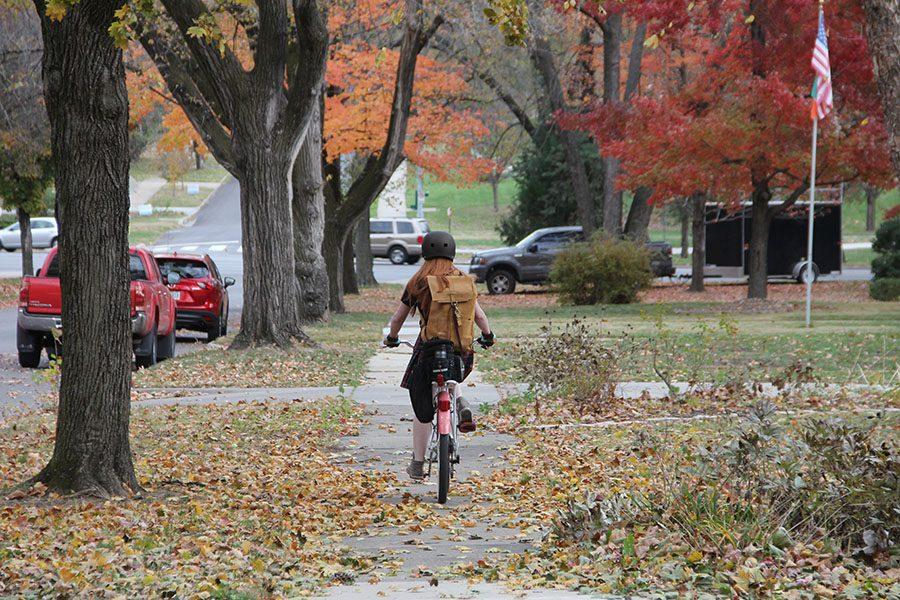Opting for an uncommon commute
Teachers and students are kicking cars to the curb in favor of buses or bikes.
Junior Isabella Fitzpatrick rides her bike down the sidewalk of E 56th Street after school Nov. 22. photo by Alex Davis
December 16, 2016
story by Julia Kerrigan
When the bell rings at 3:00 p.m., the mad dash that is dismissal begins and students rush through the halls and hop into their cars, trying to be the first out of the lot. They get home or to sports practice with little difficulty, while underclassmen impatiently wait for their moms or dads and grumble to their friends about how they’re late- again. For other students, getting home is less instantaneous.
Freshman Murphy O’Dell makes her way to the bus stop and sits down for the twenty-minute wait for the bus.
At the bike racks by Donnelly, a few people are unlocking their bikes and buckling their helmets for rides ranging from 4 to 40 minutes. Theology teacher Mike Sanem prepares himself for an uphill ride he found much more fun on the way to school that morning.
“I’m not a cyclist, I’m a little kid biker,” Sanem said. “I like to go down hills, it’s just fun to me.”
While Sanem has access to a car, he has been riding his bike to school for a year and takes pride in the fact that he is benefitting the community by lowering the number of carbon emissions. But mainly, he does it for the childlike thrill.
“I feel better when I bike to school,” Sanem said. “I don’t know if it’s exercise or just ’cause you do something fun at the beginning and the end of the day to sort of get out of the little boxes we live our lives in.”
Sophomore Elise Malone has an entirely different take on the experience.
“[My ride] is a bear,” Malone said. “It’s like 45 minutes, it sucks.”
Malone sees it as a necessity to ride her bike, no matter how grueling. She cannot drive, her parents are unable to pick her up until 6 p.m. and it is hard to come by people willing to carpool.
“Doing this kind of ruined my love of biking,” Malone said.
Junior Isabel Fitzpatrick, a licensed driver, braves a 20-minute ride for the same reason she carefully deconstructs her K-Cups every weekend in order to recycle them; the environment.
“It’s definitely made me realize that it might be slower, but it’s definitely better [for the environment],” Fitzpatrick said.
For those thinking of riding their bikes to school, Fitzpatrick advises that you strategically plan your route to avoid hills, even going so far as to have two different routes for the morning and afternoon. Malone suggests avoiding the experience altogether unless you live 20 minutes or less away. For Sanem, it’s all about safety.
“Wearing a helmet is number one,” Sanem said. “Helmets look stupid, that’s just the way it is, everybody knows that, but you will be a lot stupider with a traumatic brain injury.”
Around the time Malone reaches her home on her bike and practically collapses with her helmet in hand, sophomore Jasia Tolbert’s phone alarm is ringing, telling her it’s time to go down to the Main Street metro stop. Tolbert began regularly riding the bus to and from school freshman year.
“There are the regulars,” Tolbert said. “Like, when I get on the bus in the morning, there’s this really cute old couple that sits right in front of me and they talk about politics with each other and they read the Kansas City Star, and they’re just so cute. They’re there every single day, I love them.”
She feels it is a great way to get to know and get around the city, but it has its drawbacks.
“I always have to plan to be someplace earlier than I think I need to be, because if we’re talking about late buses, the Max is always late,” Tolbert said. “It was engineered to be the bus that would make you on time to things, but it’s always late.”
When O’Dell’s bus finally arrives, the driver asks how school was and she sits down for a 15-minute ride. Once she reaches her final stop, O’Dell rings the bell and walks the 6 or so blocks to her house.
“One time it was raining and the bus driver asked me if I wanted to be dropped off closer,” O’Dell said, smiling.
While these modes of transportation are not the most conventional, they are efficient and come with their own benefits, for getting to and from school or just around town. Tolbert especially encourages it as a way for students to get out of their comfort zone and learn more about the city.
“We’re all on this ride together,” Tolbert said.
photos by Alex Davis
[nggallery id=1356]



